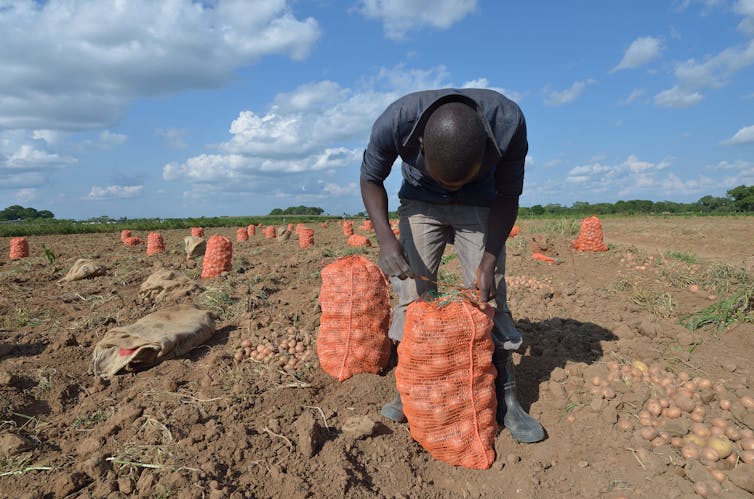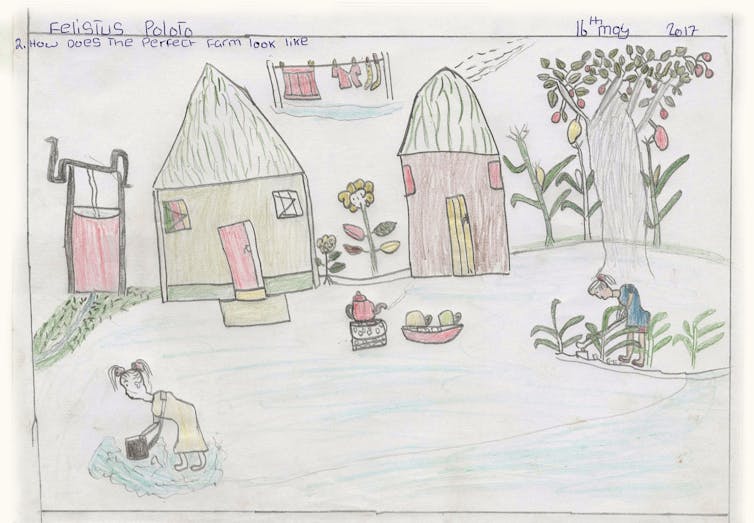
Africa has the youngest population of any continent – 60% are under age 25. While this has evoked both hope and fear, it is clear that jobs are needed for the 12 million people entering the workforce every year.
Agriculture is best suited to provide a great many jobs as it can absorb much labour, and because prospering farms trigger employment opportunities in the rest of the economy. But agriculture is often unattractive for the youth.
To lure young people into farming, policymakers and development actors emphasise the need for modern technology, including agricultural mechanisation. But surprisingly little is known about the opinion of young people in rural areas. Few have asked them what farming and rural areas need to look like to be more attractive.
I conducted a study in Zambia and asked people in rural areas aged between 12 and 20 what would make farming attractive for them. I used two research methods to explore their aspirations and perceptions: interviews as well as drawing exercises.
The results show that young people find more positive aspects in agriculture than often assumed and that the attractiveness of farming doesn’t only hinge on modern technologies. While some technologies are needed, having diverse and sustainable farms, a healthy environment and an attractive rural life is equally important.

The findings
Most of the people interviewed for the study were proud of the fact that they came from farming families that owned land and worked close to the nature. Ruth (15) expanded on this and said:
We do not pay for maize, land, water and fruits such as mangoes. We have nutritious food.
The respondents also commented on the attractiveness of the rural space. Asked where they want to live in the future, rural or urban, 53% preferred rural areas, because of their freedom and social networks.
In contrast, urban life was often perceived as bad, characterised by road accidents, pollution, Satanism, thieves and drunkards. According to Talunsa (15) people are “poisoned by alcohol and fight”.
Many also found farming unattractive, citing drudgery and weather dependence as reasons. They said they would rather aim for jobs with a regular salary such as teachers. Lozi (16) said:
I want to work with the government. Then I’ll get paid monthly.
Around half of the respondents preferred a future in urban areas rather than in rural areas. These respondents were “pulled” away from rural areas because they were attracted by the perceived positive sides of urban areas. But they were also “pushed” away from rural areas which they associate with a lot of challenges. These included the high labour burden and risks associated with farming. This is what some of the respondents said about these “push” factors:
In the village, we always eat the same, beans and nshima, and we need to work hard.“ (Elina, 16)
In the village, you can be bewitched over small disputes and the fields are very small. I prefer to live in town.” (Jakob, 15).
It’s important to note that the decision to reside either in a rural or urban area was rarely perceived as a lifetime decision. Respondents highlighted that one could work in town after harvest or for some years after school to save some money before returning to the village.
Some of my friends want to go to town but others want to stay. Of the ones who went, many came back after some years. (Alik, 14)
I want to raise some money in town but then I want to move back to my village. I will bring a tractor with me and cultivate a lot of land. (Raimond, 17)
Making farming attractive
So what does farming need to look like to be attractive?
The young people provided some direction on what they thought would make rural spaces more attractive.
The most important factors were:
Modern technologies such as tractors and digital tools. But these shouldn’t be over emphasised. Low-tech solutions shouldn’t be neglected.
Non-material factors. Making agriculture attractive requires de-risking agriculture and promoting sustainable and diverse farms. These were clearly depicted in the drawings I’d asked the respondents to sketch of their ideal farm. The drawings typically showed highly diverse farms with trees, vegetables, fruits and animals.
Ensure healthy landscapes. Having a sustainable, pollution free environment was commonly mentioned as a key advantage of rural over urban life.
Rural areas must be developed in ways that go beyond just infrastructure. Social life and networks, which are still an asset in villages compared to cities, were also cited as important. This included networks of neighbours, relatives and friend and the communal celebration of traditions.
What next
Policymakers often highlight the need for modern technologies – including information, communication and technology – when discussing rural development.
But the young respondents I spoke to emphasised more low-tech solutions such as increasing farm diversity, having water wells and using draught animals, which is already an advantage over manual labour.
This suggests that policymakers and development practitioners need to pay more attention to the actual aspirations of young people in rural areas to avoid well-intended but misguided policies. In addition, the findings suggest that there is a need for several policies to reflect several types of young people in rural areas.![]()
Thomas Daum, Agricultural Economist, University of Hohenheim
This article is republished from The Conversation under a Creative Commons license. Read the original article.

